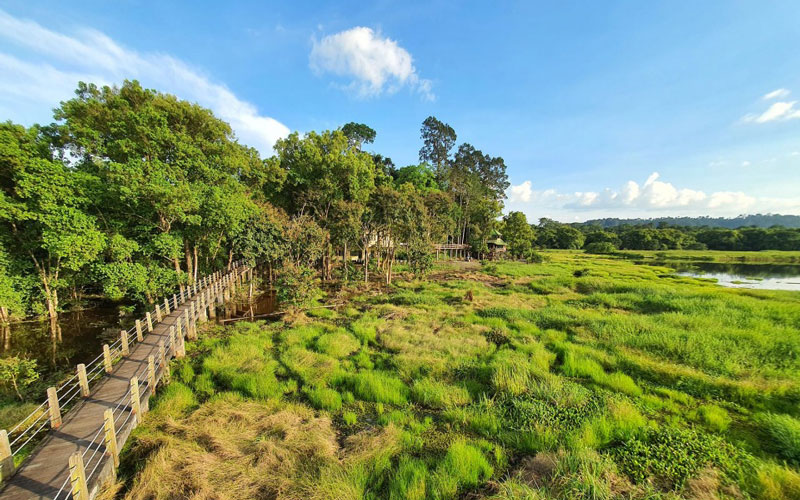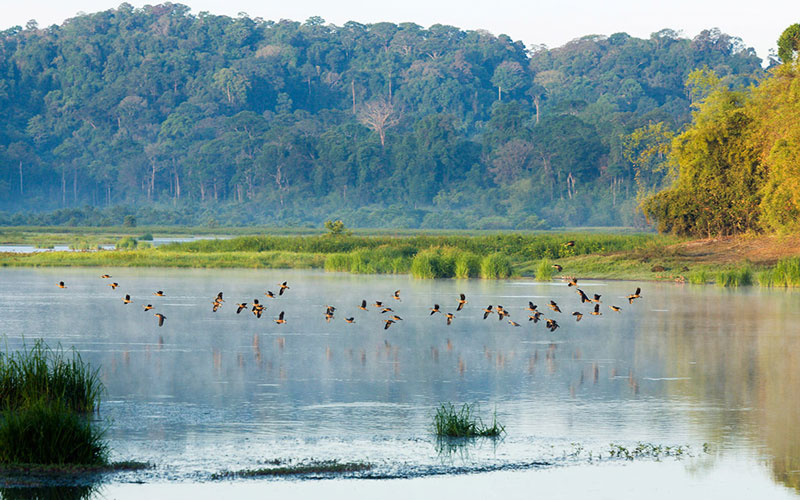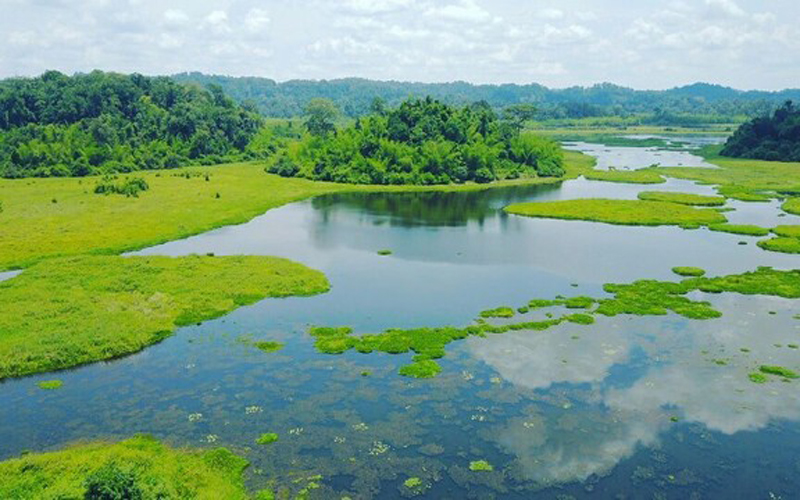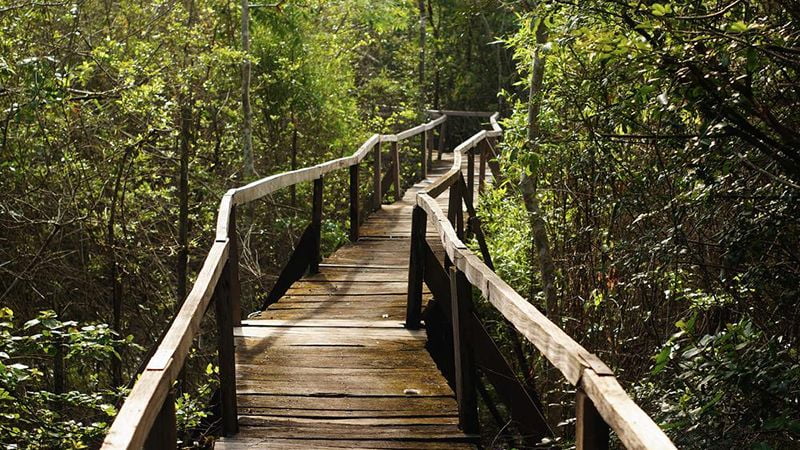Nam Cat Tien National Park

Nam Cat Tien National Park covers the provinces of Dong Nai, Lam Dong and Binh Phuoc. It has an area of 71,920 ha and is divided into two distinct parts: to the north, Cat Loc and to the south, Nam Cat Tien. Upon arrival, the park offers you the opportunity to discover nature and contemplate the beauty of the mountains, forests of tall trees, waterfalls and ecosystems diversified with unique plant and animal species.
It is the biological richness, the diversity of the fauna and the flora, the variety of the landscapes ... which make this park known globally to not only the Vietnamese, but also the foreigners. There are over 1610 plant varieties, 351 bird species, 105 mammal species, 130 freshwater fish species, 120 reptile and amphibian species, and hundreds of butterfly species and insects in this park. The park is known to have hosted a small population of Java rhinos.
During your ecotourism stay, you can discover the cultural relics of Oc Eo and visit the ethnic villages of Ma and S'tieng in Ta Lai commune.
As a UNESCO Biosphere Reserve, Nam Cat Tien plays a crucial role in safeguarding Vietnam's natural heritage and provides opportunities for immersive experiences like trekking, wildlife watching, and birdwatching. With accommodation options that allow you to dwell in harmony with nature, this national park beckons explorers to uncover its ecological wonders and contribute to its ongoing conservation efforts.
One of the most significant milestones in the park's history came in 2001 when it earned the prestigious title of a UNESCO Biosphere Reserve. This designation elevated Nam Cat Tien to global prominence, recognizing its pivotal role in biodiversity conservation and scientific research.
However, Nam Cat Tien has not been immune to the ongoing challenges that face protected areas worldwide. Issues such as illegal logging, poaching, and habitat degradation have persisted, necessitating vigilant conservation measures and the dedication of environmental advocates.
In recent years, sustainable tourism has emerged as an essential aspect of the park's management strategy. Nam Cat Tien National Park has attracted nature enthusiasts, researchers, and tourists eager to explore its diverse landscapes, all while contributing to its continued preservation.
Today, Nam Cat Tien stands as a living testament to resilience and dedication. It has transcended its troubled past to become a symbol of environmental stewardship and a beacon for those passionate about protecting our planet's fragile ecosystems. As it continues to evolve, Nam Cat Tien National Park exemplifies the enduring importance of safeguarding our natural heritage for future generations to cherish and study.
Nam Cat Tien National Park, situated in southern Vietnam, experiences a tropical monsoon climate, which divides the year into two distinct seasons. From December to April, the dry season prevails, providing visitors with a comfortable and rain-free environment to explore its lush landscapes. During this time, temperatures range from 20°C to 30°C (68°F to 86°F), making it an ideal period for outdoor adventures like hiking and wildlife spotting. As the wet season takes over from May to November, heavy rainfall and high humidity become the norm, creating a verdant and thriving ecosystem. While the wet season may not be everyone's cup of tea due to the rain and occasional flooding, it offers a unique opportunity to witness the park's abundant flora and fauna in their full glory. Whether you prefer the dry season's comfort or the wet season's vibrant greenery, Nam Cat Tien National Park beckons with its natural wonders year-round.

View of Nam Cat Tien forest
1. Bau Sau (Crocodile Lake): Bau Sau, also known as Crocodile Lake, is one of the park's most iconic features. This picturesque lake is surrounded by dense jungle and is home to a variety of wildlife, including crocodiles and various bird species. Visitors can take a boat tour on the lake to appreciate its natural splendor and observe the wildlife.
 Crocodile Lake
Crocodile Lake
2. Botanical Garden: The park's botanical garden is a hub for researchers and nature enthusiasts. It houses a wide array of plant species, including many rare and endemic ones. Visitors can explore the garden's well-maintained trails and learn about the park's diverse flora.

Explore the park's botanical garden, home to a variety of native plant species
3. Canopy Walkway: Explore the forest from a unique perspective by taking a walk on the canopy walkway. It provides a bird's eye view of the lush treetops.

Explore the unique canopy walkway at Nam Cat Tien National Park
4. Bird Watching Sites: Nam Cat Tien is a haven for birdwatchers. The park offers several birdwatching sites where you can spot a diverse range of bird species. Birdwatchers flock to the park to glimpse some of Vietnam's most elusive and beautiful birds.
.jpg)
Male Germain’s Peacock pheasant from hide in Cat Tien National Park
5. Trails and Trekking: The park features a network of well-marked trails that allow visitors to explore its pristine wilderness. Popular trails include the Crocodile Lake trail and the Dao Tien Endangered Primate Species Center trail. These trails offer opportunities to experience the park's biodiversity up close.
.jpg)
Nam Cat Tien trekking tour
Entrance Fee: The entrance fee for foreign visitors was approximately 60,000 VND (Vietnamese Dong), which is equivalent to about $2.50 USD.
Boat Tours and Activities: Some activities within the park, such as boat tours and guided treks, may have additional fees. These fees can vary depending on the specific activity and whether you choose to take a guided tour.
Embarking on a journey to Nam Cat Tien National Park involves navigating a captivating blend of natural beauty and adventure. Starting from the vibrant metropolis of Ho Chi Minh City, a 3-4 hour road trip offers a chance to witness the changing landscapes of southern Vietnam. Whether you choose to hire a private car for a comfortable ride or opt for an affordable bus option, the journey promises glimpses of local life and rural scenery. Upon arrival at the park's entrance, the real exploration begins. Within the park, various modes of transportation such as walking, cycling, or guided tours allow you to immerse yourself in the lush rainforests and vibrant ecosystems.
Read more: Northern Vietnam In Depth tour